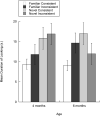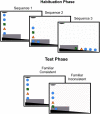Development of ordinal sequence perception in infancy
- PMID: 23587035
- PMCID: PMC3954567
- DOI: 10.1111/desc.12029
Development of ordinal sequence perception in infancy
Abstract
Perception of the ordinal position of a sequence element is critical to many cognitive and motor functions. Here, the prediction that this ability is based on a domain-general perceptual mechanism and, thus, that it emerges prior to the emergence of language was tested. Infants were habituated with sequences of moving/sounding objects and then tested for the ability to perceive the invariant ordinal position of a single element (Experiment 1) or the invariant relative ordinal position of two adjacent elements (Experiment 2). Experiment 1 tested 4- and 6-month-old infants and showed that 4-month-old infants focused on conflicting low-level sequence statistics and, therefore, failed to detect the ordinal position information, but that 6-month-old infants ignored the statistics and detected the ordinal position information. Experiment 2 tested 6-, 8-, and 10-month-old infants and showed that only 10-month-old infants detected relative ordinal position information and that they could only accomplish this with the aid of concurrent statistical cues. Together, these results indicate that a domain-general ability to detect ordinal position information emerges during infancy and that its initial emergence is preceded and facilitated by the earlier emergence of the ability to detect statistical cues.
© 2013 Blackwell Publishing Ltd.
Figures




Similar articles
-
Sequence learning in 4-month-old infants: do infants represent ordinal information?Child Dev. 2009 Nov-Dec;80(6):1811-23. doi: 10.1111/j.1467-8624.2009.01369.x. Child Dev. 2009. PMID: 19930353
-
Discrimination of ordinal relationships in temporal sequences by 4-month-old infants.Cognition. 2020 Feb;195:104091. doi: 10.1016/j.cognition.2019.104091. Epub 2019 Nov 15. Cognition. 2020. PMID: 31739006
-
The development of ordinal numerical knowledge in infancy.Cognition. 2002 Apr;83(3):223-40. doi: 10.1016/s0010-0277(02)00005-7. Cognition. 2002. PMID: 11934402
-
The developmental origins of naïve psychology in infancy.Adv Child Dev Behav. 2009;37:55-104. doi: 10.1016/s0065-2407(09)03702-1. Adv Child Dev Behav. 2009. PMID: 19673160 Review.
-
Infants' sensitivity to pictorial depth cues: a review and meta-analysis of looking studies.Infant Behav Dev. 2012 Feb;35(1):109-28. doi: 10.1016/j.infbeh.2011.08.003. Epub 2011 Sep 4. Infant Behav Dev. 2012. PMID: 21893347 Review.
Cited by
-
Sample size, statistical power, and false conclusions in infant looking-time research.Infancy. 2017 Jul-Aug;22(4):436-469. doi: 10.1111/infa.12186. Epub 2014 Apr 5. Infancy. 2017. PMID: 28966558 Free PMC article.
-
Active Drumming Experience Increases Infants' Sensitivity to Audiovisual Synchrony during Observed Drumming Actions.PLoS One. 2015 Jun 25;10(6):e0130960. doi: 10.1371/journal.pone.0130960. eCollection 2015. PLoS One. 2015. PMID: 26111226 Free PMC article.
-
Infants learn better from left to right: a directional bias in infants' sequence learning.Sci Rep. 2017 May 26;7(1):2437. doi: 10.1038/s41598-017-02466-w. Sci Rep. 2017. PMID: 28550288 Free PMC article.
-
The multi-component nature of statistical learning.Philos Trans R Soc Lond B Biol Sci. 2017 Jan 5;372(1711):20160058. doi: 10.1098/rstb.2016.0058. Philos Trans R Soc Lond B Biol Sci. 2017. PMID: 27872376 Free PMC article. Review.
References
-
- Allen TW, Walker K, Symonds L, Marcell M. Intrasensory and intersensory perception of temporal sequences during infancy. Developmental Psychology. 1977;13:225–229.
-
- Chang HW, Trehub SE. Auditory processing of relational information by young infants. Journal of Experimental Child Psychology. 1977a;24(2):324–331.
-
- Chang HW, Trehub SE. Infants' perception of temporal grouping in auditory patterns. Child Development. 1977b;48(4):1666–1670. - PubMed
Publication types
MeSH terms
Grants and funding
LinkOut - more resources
Full Text Sources
Other Literature Sources
Medical

